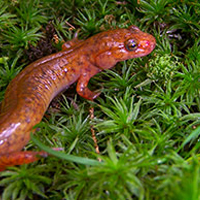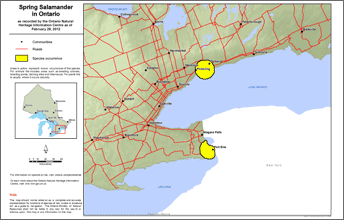Spring Salamander
Scientific name: Gyrinophilus porphyriticus

Cover photo credit: Rob Tervo
Status
Extirpated
“Extirpated” means the species lives somewhere in the world, and at one time lived in the wild in Ontario, but no longer lives in the wild in Ontario.
Date added to the Species at Risk in Ontario List
The spring salamander was already assessed as extirpated when the Endangered Species Act took effect in 2008.
Read the assessment report.
What it looks like
The Spring Salamander is the largest member of the lungless salamander family in Canada, growing up to about 20 centimetres long. Lungless salamanders “breathe” through their skin, especially the lining of the mouth.
Spring Salamanders are pinkish or yellowish brown with irregular darker markings and a stripe from below each eye to the nostrils.
Where it lives
Spring Salamanders live in springs, seepages and mountain streams. They must keep their skin moist for respiration and seldom leave the water, although adults will use terrestrial areas within two metres of the stream edge. Females lay their eggs underground beneath the streams and seeps. This species overwinters in the stream bottom or refuges under the banks to avoid freezing.
Where it’s been found in Ontario
In Ontario, there are only two historical records of the Spring Salamander, both difficult to confirm. One record is of larvae from near Ottawa (although the locality information is questionable) and the other of larvae collected from a stream in the Niagara region in 1877. This salamander has not been reported in Ontario since then.
The Spring Salamander lives in the Appalachian region of eastern North America, ranging from southern Quebec to Georgia and Mississippi and west to West Virginia. In Canada it is now found only in Quebec.
View a Larger version of this map (PDF)
Why it disappeared from Ontario
Due to the limited records in Ontario, historic threats cannot be determined.
Action we are taking
Extirpated species and their habitat are protected if the species are again found in Ontario.
Help Make Sure We Don’t Lose More Endangered Species in Ontario
- Watch for reptiles and amphibians that may be crossing roads between May and October. Road mortality is a serious threat to many of these species. If it is safe to do so, help reptiles and amphibians across the road in the direction they were headed.
- Report any illegal activity related to plants and wildlife to
1-877-TIP-SMNR (847-7667) . - Private land owners have an important role to play in species recovery. You may be eligible for stewardship programs that support the protection and recovery of species at risk and their habitats.
- Volunteer with a local nature club or provincial park to participate in surveys or stewardship work focused on species at risk.
- Visit the Ontario Reptile and Amphibian Atlas or Toronto Zoo Adopt-a-Pond website to learn more about Ontario’s rare snakes, their habitat and related conservation initiatives.
Quick facts
- This amphibian is named for the habitat it prefers: cool, clear, spring-fed streams.
- These salamanders live as larvae for up to six years, and live a total of 10 years or longer.
- Toxic secretions from its skin and its red colour, which mimics even more toxic species, are thought to protect adult Spring Salamanders from land-based predators.
- The Spring Salamander consumes a wide variety of food: insects, crustaceans, centipedes, millipedes, earthworms, snails, spiders, and occasionally small frogs and salamanders, including their own species.
